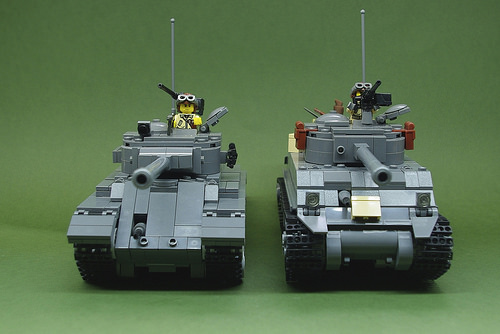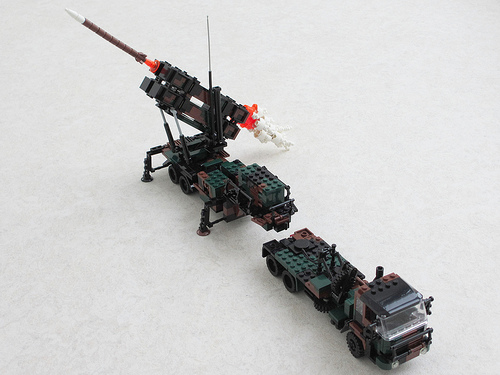Last May, Dan Siskind of Brickmania launched a Kickstarter campaign to fund the production of a new kind of track elements designed to work with LEGO. Early this year, my backer reward package arrived, and I’ve been building (and rebuilding) furiously ever since.

My new M4A1 Sherman with a dozer attachment is typical of the engineering vehicles used during the invasion of Normandy, with deep wading snorkels that enabled the tank to be dropped off farther from shore and drive mostly underwater on the sea floor. (I think Dan’s design for his early-production M4 Sherman turret can’t be improved, so I replicated his turret design while adding my own gun barrel for consistency with the rest of my tanks.) Both the M4A3 on the left and the dozer tank use two-wide Track Links, while the M4A3E2 Sherman “Jumbo” on the right uses official three-wide LEGO tracks.
In order to switch the M4A3 with the short 75mm gun barrel from its existing three-wide LEGO track to Track Links, I had to rebuild the suspension. As a result, I don’t think this version — possibly my last — shares more than a few bricks with my original attempt at a Sherman that I first posted nearly four years ago.
LEGO currently produces three types of elements that builders use as tank treads, and all of them are hard to get in any significant quantity (and thus fairly expensive). For those of us who build historical or real-world LEGO models, each of these also has unique problems:
- One-wide Technic chain link: The open chain links don’t look a whole lot like actual tank treads.
- Three-wide Technic tread: The best official LEGO option for many tanks, but three studs wide is one stud too many for most American tanks of World War II.
- Five-wide tread with Technic pin holes: Far too huge for anything most minifig-scale applications.
The most significant gap in available parts is the lack of any official two-wide track. Using two parallel sets of Technic chain link (as I did on my M7 Priest) is cost-prohibitive at best, and doesn’t look all that great. From a historical standpoint, German and Russian tank designers realized that relatively narrow track would just sink in mud, miring and thus disabling the tank. As WWII veteran Belton Cooper described in Death Traps, American tank designers didn’t get that memo. To build historically accurate American tanks, LEGO military modelers need something other than the official LEGO options.
American tank designers didn’t get that memo. To build historically accurate American tanks, LEGO military modelers need something other than the official LEGO options.
The two-wide Track Links tracks work beautifully on American medium tanks like the M3 Lee/Grant, M4 Sherman, and all the tracked vehicles based on their chassis (such as the M7 Priest and most WWII tank destroyers). Dan himself has been replacing the existing track on many of his vehicles with Track Links, including this beautifully camouflage-patterned M3 Grant and M10 tank destroyer.


Just like regular LEGO track, Track Links clip together with small pins on each side, and they work well with a variety of LEGO gears. Both the single-wide and double-wide Track Links wrap around the gears better than LEGO tracks or chain links, and they roll just as well. Here’s my M3A1 Stuart light tank sporting the single-wide Track Links.

On a related note, you’ll notice that many military builders have begun using the new BrickArms M2HB .50 caliber machine gun. I still like my own brick-built .50 cal, but it’s also nice to have an absolutely accurate option that’s consistent with the BrickArms .30 caliber M1919 Browning machine gun.

In addition to Track Links and a .50 cal, my M8 Scott 105mm Howitzer Motor Carriage (with a gun that elevates/depresses and an ammunition trailer) includes several other custom elements:
- Brickmania armored division minifig
- BrickArms shells
- Citizen Brick diamond plate tiles
Will Chapman gave away several prototype M2HBs at BrickCon, and now the production version is available from resellers like Brickmania and G.I. Brick. One difference between the initial prototype and the final production version is that the ammunition canister is a bit looser. It won’t fall out, but it does have a tendency to flop around a bit. Based on the high quality we’ve come to expect from BrickArms over the years, I’m confident that a bit of retooling will address this minor issue soon.
Brickmania Track Links are available in three colors — black, steel, and reddish brown (great for mud/rust) — on Brickmania.com, along with the new BrickArms M2HB.
I’ll also be posting reviews of several Brickmania kits that include Track Links over the next week or two, so check back here for more.
The Brothers Brick is funded by our readers and the community. Articles may include affiliate links, and when you purchase products from those links, TBB may earn a commission that helps support the site.



















